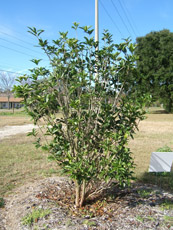Osmanthus fragrans (Sweet Olive)

*Click on picture for more images of this species.
- USDA Hardiness Zone: 7B - 9B
- Mature Height: 15 to 30 ft
- Mature Spread: 15 to 20 ft
- Growth Rate: Slow
- Availability: Generally available
- Drought Tolerance: Moderate
- Salt Tolerance: Poor
- Light Requirements: Full sun to partial sun.
- Native Origin: Not native to North America. Invasive potential has not been assessed.
- Soil Drainage: Needs a well-drained site
- Foliage: Evergreen tree with no showy fall color.
- Flowers: White, showy, fragrant flowers from fall to spring.
- Pests: Free of serious pests and diseases, although scales and nematodes can be a problem.
- Description: Sweet Olive, a large evergreen shrub or small tree, is capable of reaching 20 to 25 feet in height and width but is most often seen at 10 to 12 feet high with an 8-foot-spread. Older plants grow as wide as tall and develop a vase shape with several main trunks typically originating close to the ground. The lustrous, medium-green leaves have paler undersides and are joined from October through March by a multitude of small, but extremely fragrant, white blossoms. They perfume a large area of the landscape and can be showy in some years. With its upright oval to columnar growth habit in youth, Sweet Olive is ideal for use as an unclipped hedge or trained as a small tree, and should be placed where its fragrance can be enjoyed. Since the flowers are not particularly showy, people will wonder where the delightful fragrance is coming from. Plants thin somewhat in the partial shade, but form a dense crown in a sunny location. Planted on 4 to 6 foot centers, Sweet Olive can form a wall of fragrance from fall to spring and should be planted more often. They will not grow as fast as Leyland Cypress, but think of this Sweet Olive as a substitute for use in a sunny spot. Plants can be clipped to form a denser canopy, but flowers form on old growth and removing branches will reduce the flower display. With time, older plants can be trained into a small, multi-trunked tree. Sweet Olive should be grown in full sun or partial shade in well-drained soil. Plants are fairly drought-tolerant once established but will perform their best with ample moisture.
- North Central Florida Observations:
- Fact Sheet

